Blog
Changwen is a leading cooking utensils manufacturers. We supply high quality stainless steel cooking pots and pans to all over the world. We can also customize the local hot-selling stainless steel pots and pans. Please send your requirements to Changwen.
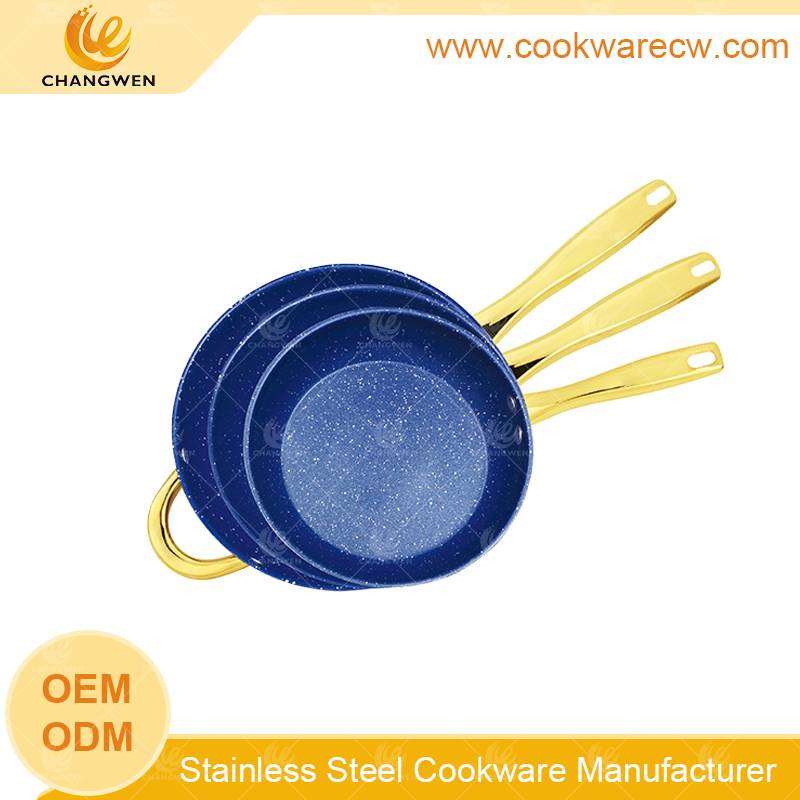
Best Stainless Steel Nonstick Cookware
What is the best stainless steel nonstick cookware?
Stainless steel nonstick cookware is a composite kitchenware that combines stainless steel material and non-stick coating, combining the durability of stainless steel and the easy cleaning of non-stick coating. The so-called “best” products must meet the following core standards:
Material safety: Meet food-grade standards (such as 304/316 stainless steel + FDA-certified non-stick coating).
Non-stick performance: The coating has strong adhesion and the friction coefficient is ≤0.1.
Durability: The coating life is ≥2 years (daily use in the home) or 5 years (commercial scenarios).
Compatibility: Suitable for gas stoves, induction cookers, ovens and other heating methods.
Environmental compliance: The coating material is non-toxic and harmless, and complies with international standards such as RoHS and REACH.
Core features of stainless steel non-stick cookware
1. Material and structure
Base material selection:
304 stainless steel: general type, strong corrosion resistance, suitable for household pots.
316 stainless steel: medical grade, acid and alkali corrosion resistant, suitable for coastal or high-salt environments.
430 stainless steel: economical, containing 16-18% chromium, but weak rust resistance (mostly used for accessories).
Composite structure: Three-layer composite pot: outer layer of stainless steel (anti-deformation) + middle layer of aluminum/copper (heat conduction) + inner layer of stainless steel + non-stick coating (anti-stick).
Single-layer stainless steel pot: direct spray coating, the substrate surface needs to be flat and smooth.
2. Non-stick coating type
| Coating type | Composition and characteristics | Applicable scenarios |
|---|---|---|
| PTFE (polytetrafluoroethylene) | Traditional Teflon coating, with extremely low friction coefficient (0.04-0.1), requires high temperature sintering (≥260℃). | Household woks and frying pans |
| Ceramic coating | Inorganic silicate-based coating, resistant to high temperatures (≤450℃), without chemical additives, but weak wear resistance. | Non-stick pans, baking molds |
| Diamond coating | Nano-diamond particle reinforced coating, hardness up to HV 1000, lifespan increased by 3-5 times. | High-end commercial cookware |
| Titanium coating | Titanium alloy substrate + PTFE, combining metal strength and non-stick properties, anti-scratch ability is better than ordinary PTFE. | Knives, frying pans |
| Graphene coating | Single-layer graphene film, uniform thermal conductivity and strong hydrophobicity, high cost. | Laboratory-grade or high-end home appliance cooking utensils |
3. Performance advantages Non-stick: The microporous structure on the coating surface reduces the contact area between food and metal.
High temperature resistance: Some coatings can withstand high temperatures of 300-450℃ (such as ceramic coatings).
Easy to clean: Food residues are not easy to adhere, and can be cleaned by water.
Health: No PFOA/PTFE residue (need to look for the “Free of PFOA” logo).
4. User experience design
Anti-scalding handle: Fully insulated handle (temperature resistance ≥ 200℃).
Edge sealing: Seamless welding technology to prevent coating peeling.
Lightweight: Weight is controlled at 1.2-1.8kg (30cm diameter pot).
Versatility: Compatible with accessories such as steamers and lid hooks.
Key conditions for manufacturing stainless steel non-stick cookware
1. Material and equipment requirements
Substrate standard:
Stainless steel sheet thickness ≥ 0.8mm (pot) or 0.5mm (tableware).
Surface roughness Ra ≤ 0.1μm (to ensure coating adhesion).
Coating raw materials:
PTFE must comply with FDA 21 CFR 175.300.
Ceramic coating must pass SGS testing (heavy metal migration ≤ 0.1mg/dm²).
2. Production process flow
Substrate pretreatment:
Degreasing and cleaning (alkaline solution 60-80℃) → pickling (nitric acid concentration 10-15%) → passivation (chromate treatment).
Coating spraying:
PTFE coating: electrostatic spraying (thickness 20-50μm) → high temperature sintering (380-420℃).
Ceramic coating: plasma spraying (thickness 10-30μm) → low temperature curing (180-220℃).
Post-processing process:
Polishing (Ra≤0.4μm) → edge grinding → air tightness test (water pressure 100kPa for 5 minutes).
3. Quality control nodes
Adhesion test: tape sticking method (ASTM D3330 standard, shedding area ≤5%).
Abrasion test: steel wool rubbed 500 times without damage (load 2kg).
Heat resistance test: thermal shock test (200℃→cold water quenching cycle 50 times without cracking).
Food safety test: Migratable heavy metals (lead, cadmium) ≤0.1mg/kg.
4. Technical difficulties and innovations
Coating adhesion improvement: Enhance bonding strength through laser micro-etching (surface roughness Ra 0.2-0.3μm).
Environmental alternatives: Develop bio-based non-stick coatings (such as cellulose nanocrystalline coatings).
Ultra-thin design: The substrate thickness is reduced to less than 0.5mm, and a composite support structure is required to prevent deformation.
Customization Guide for Stainless Steel Non-stick Cookware
1. Customization Requirements Analysis
Functional requirements:
Coating type (PTFE/ceramic/diamond).
Heating method (gas/induction cooker/oven compatible).
Appearance requirements:
Surface treatment (brushed, mirror polished, etched pattern).
Color scheme (brand color customization, support Pantone color number).
2. Design support and proofing
Structural design:
Anti-scalding handle design (ergonomic).
Multifunctional accessories (detachable steamer, thermometer hole).
Proofing process:
Provide 3D drawings (STEP format).
Mold opening fee (about $800-3000, depending on complexity).
Proofing cycle: 15-30 days (coating process takes 50% of the time).
3. Mass production and delivery
Mass production cycle: 30-60 days (first batch of orders).
Packaging requirements:
Inner layer: EPE pearl cotton shockproof.
Outer layer: carton + moisture-proof film (humidity ≤ RH 40%).
4. Cost control and intellectual property protection
Cost optimization:
Reduce mold opening costs: reuse existing molds (such as general pot types).
Scale procurement: centralized procurement of coating raw materials (cost reduction of 10-15%).
Intellectual property protection:
Sign a confidentiality agreement (NDA).
Apply for appearance patent (search for design uniqueness in advance)
Wholesale and customization
Wholesale:
Find suppliers: You can find suppliers of stainless steel non-stick kitchenware through online platforms, exhibitions and other channels.
Understand the product: Communicate with the supplier to understand the product’s performance, price, specifications and other information.
Sign a contract: After the two parties reach a cooperation intention, sign a formal purchase contract.
Pay the payment: Pay the payment in accordance with the contract agreement.
Receipt and acceptance: Accept the goods after receiving them to ensure that the product quality meets the agreement.
Customization:
Demand communication: Communicate with the supplier about your customization needs, including the shape, size, color, non-stick coating type, etc. of the kitchenware.
Design confirmation: The supplier provides a design plan based on the needs, and the customer enters the production stage after confirmation.
Production monitoring: Customers can understand the production progress and product quality in real time.
Delivery and acceptance: Deliver at the agreed time and place, and the customer accepts and pays the balance.
During the customization process, customers can choose different materials, processes and coating types according to their needs and budget. At the same time, suppliers can also provide OEM/ODM services to tailor stainless steel non-stick cookware that meets the customer’s brand style and market needs.
.
Common problems and solutions
1. How to solve the problem of coating peeling?
Reason: Incomplete pretreatment of the substrate or high temperature exceeding the coating tolerance limit.
Solution:
Optimize the cleaning process before spraying (ultrasonic cleaning + pure water rinsing).
Limit the maximum operating temperature (PTFE coating ≤ 260℃).
2. How to extend the life of the coating?
Recommendations for use:
Avoid metal spatulas (use silicone/wooden spatulas instead).
Do not use steel wool when cleaning.
Process improvement:
Use multi-layer composite coatings (such as PTFE+ceramic).
Increase surface hardness (HV≥500).
3. How to deal with international certification barriers?
EU market: LFGB certification (focus on detecting migratory substances).
US market: FDA registration + NSF certification (required for commercial products).
Japanese market: JIS A 4805 standard (salt spray resistance test).
4. Why is a non-stick pan non-stick?
Non-stick pans are non-stick through coating. That is, a layer of coating is applied on the surface of the original pan base. The coating separates the food and the pan.
5. What material should I choose for a non-stick pan?
Non-stick pans are made of a variety of materials, such as Teflon, stainless steel, ceramic, cast iron, etc. The surface of the Teflon coating is extremely smooth, food is not easy to stick to, and cooking and cleaning are very convenient. Stainless steel material is harmless to the human body, the pot body is sturdy and durable, not easy to deform, and has a long service life. The ceramic coating does not contain harmful chemicals, has a smooth surface, has good non-stick properties, and food is not easy to stick to. Cast iron pans are sturdy and durable, have a long service life, and can withstand high-temperature cooking.
Changwen is a professional stainless steel non-stick cookware factory, which can provide non-stick cookware with different sizes and coatings. We are able to wholesale and produce a wide range of non-stick cookware at competitive prices, and customize non-stick cookware according to your needs.
Popular Blog
How to pre-seasoned stainless steel pot
Which is better 18/10 or 18/8 stainless steel cookware?
What materials can you choose for custom cookware?
What is the difference between stainless steel 18/10 and 18/8
Why choose 180/8 material for stainless steel cookware?
Why do stainless steel pots stick?
What material is good for stainless steel frying pan?
how to get custom made cookware
Precautions for the use of stainless steel frying pan?
Tags
Recommend Products
-
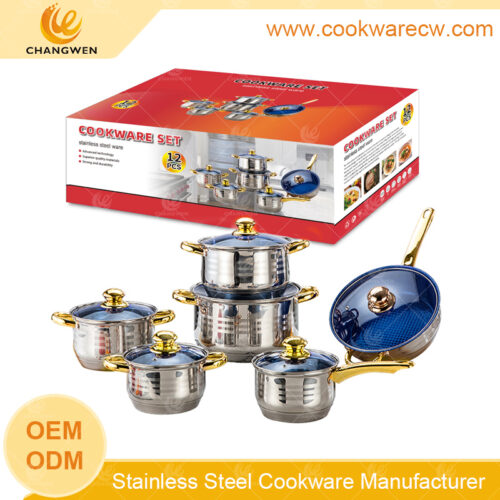
hot sales 12pcs stainless steel cookware set saucepan casserole non-stick frypan with golden handles & knobs & 5-stepped capsule bottom CW-M1202
-
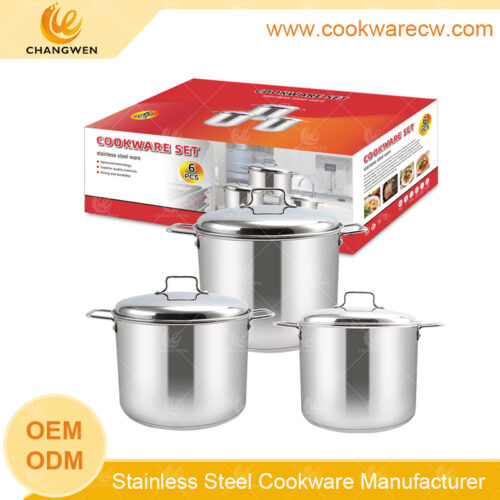
Customize color box high soup stock pot set stainless steel lids and knobs large volume 10L 13L 15L cookware pots wholesale CW-M0602
-
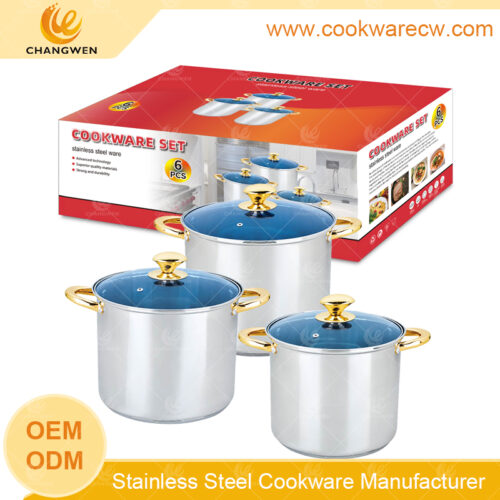
High quality stainless steel pots 6pcs soup stock pot set 11L 13L 16L large capacity cookware with gold plated hollow handle and glass lid CW-M0607
-
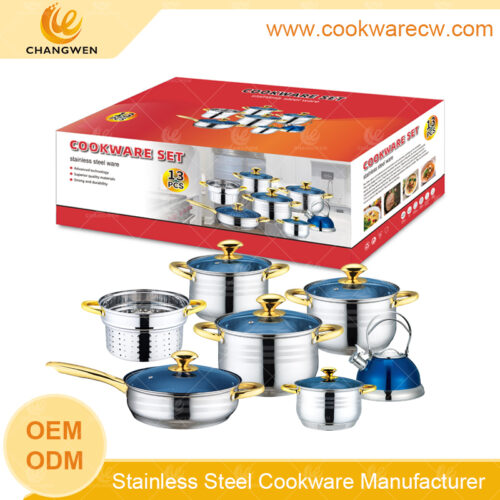
Mercado Libre stainless steel 13pcs cookware set tea kettle pasta pot nonstick frying pan golden handle blue coating CW-M1305
-
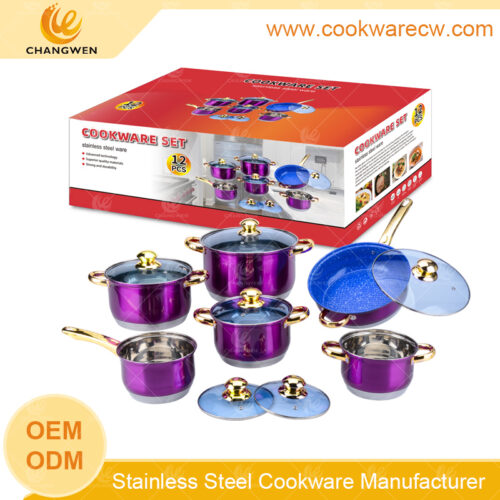
color coating surface stainless steel pots non-stick frypan golden S/S handles and knobs 430 protector for induction CW-M1225
-
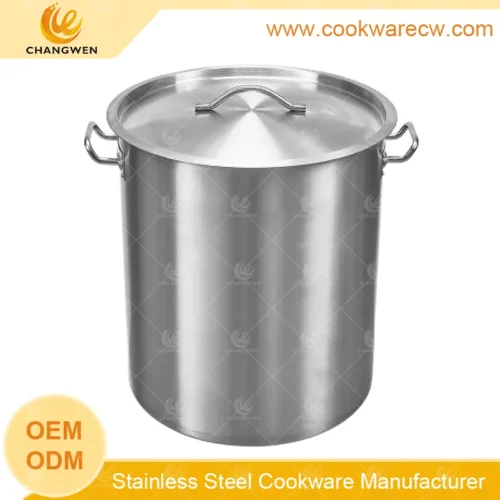
Commercial Stainless Steel Stock Pot CW-SP001
-
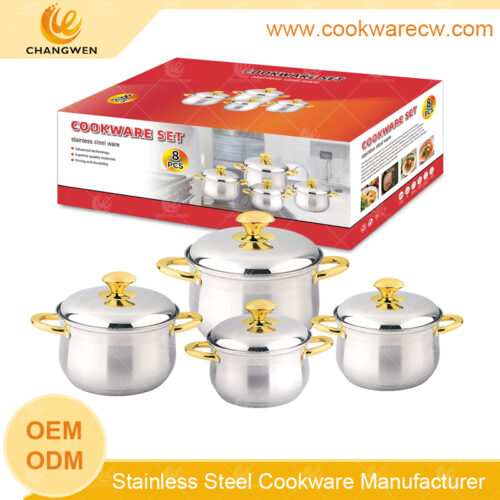
8pcs casserole cookware with golden handles & knobs stainless steel lid with holes soup stock pot ollas with heavy kgs weights CW-M0802
-
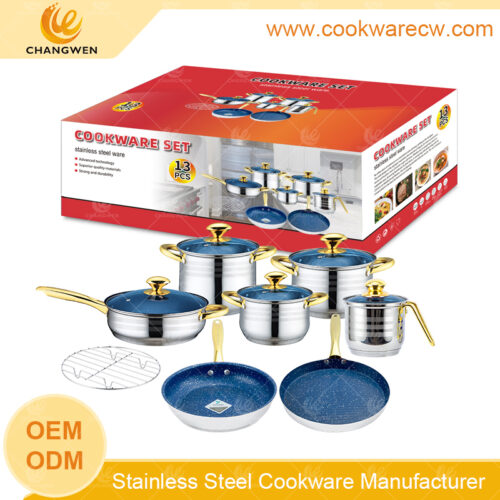
Mexican cookware set olla milk pot high stock pot kitchen wire rack and non-stick coating frypans CW-M1308
